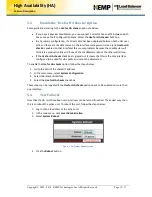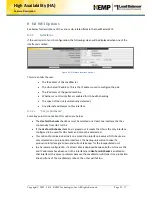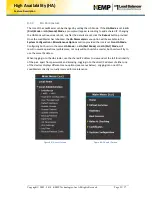
Copyright © 2002 - 2014 KEMP Technologies, Inc. All Rights Reserved. Page 24 / 37
High Availability (HA)
Feature Description
No HA
icons
If the HA status squares are not appearing in the WUI, it
probably means that HA is not enabled. Go to
System
Administration > Miscellaneous Options > HA Parameters
and ensure the
HA Mode
is set to either
First
or
Second
.
In HA mode, each LoadMaster will have its own IP address which is used only for diagnostic
purposes directly on the unit. The HA pair have a shared IP address over which the WUI is used
to configure and manage the pair as a single entity.
Both HA1 and HA2 must be on the same subnet with the same default
gateway and be located within the same physical site. They must not be
separated by an intra-site link and must use the same gateway to return
traffic.
HA Mode
If using a single LoadMaster, select
Non HA Mode
. When setting up HA mode, one LoadMaster
must be set to
HA (First) Mode
and the other
HA (Second) Mode
. HA will not operate if both
units have the same
HA Mode
.
HA Timeout
CARP requests are sent every second from the master. The value selected in the
HA Timeout
drop-down list is the time that the master machine must be unavailable before a switchover
occurs. With this option, the time it takes an HA cluster to detect a failure can be adjusted from
3 seconds to 15 seconds in 3 second increments. The default value is 9 seconds. A lower value
will detect failures sooner, whereas a higher value gives better protection against a DOS attack.
HA Initial Wait Time
How long after the initial boot of a LoadMaster, before the machine decides that it should
become active. If the partner machine is running, then this value is ignored. This value can be
changed to mitigate the time taken for some intelligent switches to detect that the LoadMaster
has started and to bring up the link.
HA Virtual ID
When using multiple HA LoadMaster clusters (or other devices using CARP-like protocols) on the
same network, this value uniquely identifies each cluster so that there are no potential
unwanted interactions.
KEMP highly recommends using a higher value than 10, as any other HA device using the same
ID could interfere with HA operations.




























